VIBES - Turn 1 Flying Penguin - Protoaddict
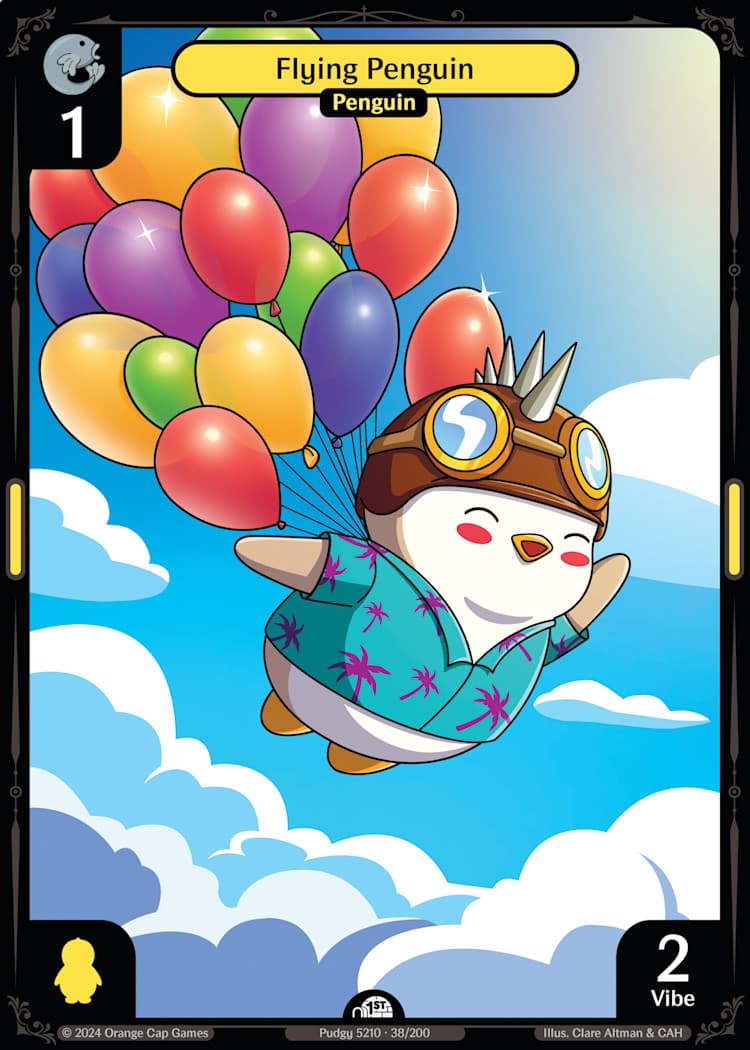
The Most Important 1 Drop in the Game
Let me ask you a simple question. You are playing a Yellow deck and your opening hand contains a Flying Penguin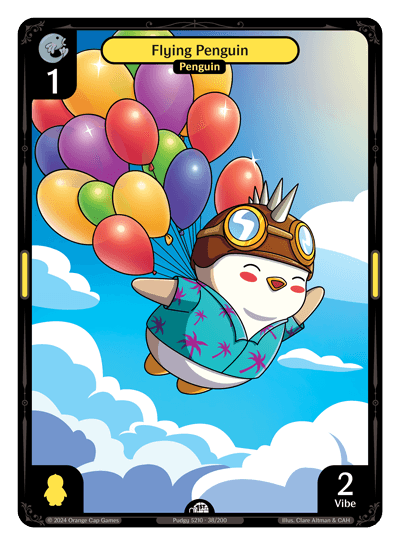 , should you play it on turn one?
, should you play it on turn one?
A lot of player reaction to this question is probably going to be a snap answer of yes, of course you do. It gets you ahead on board, wins you the vibe check early, ramps your rods. Why would you ever not play it on turn one? What if I told you for Yellow decks, this is quite possibly the most determinative play in the entire match and the decision you make here can be the pivot point between winning and losing most of your games? What if I told you that not playing it on turn one is very often the correct play?
The Dynamics of 1 Drops in Vibes
I am going to use Flying Penguin as my example for this discussion, but note that this decision point can be equally salient in Red decks playing Contemplation Penguin
as my example for this discussion, but note that this decision point can be equally salient in Red decks playing Contemplation Penguin and equally relevant with Penguin Who Zooms
and equally relevant with Penguin Who Zooms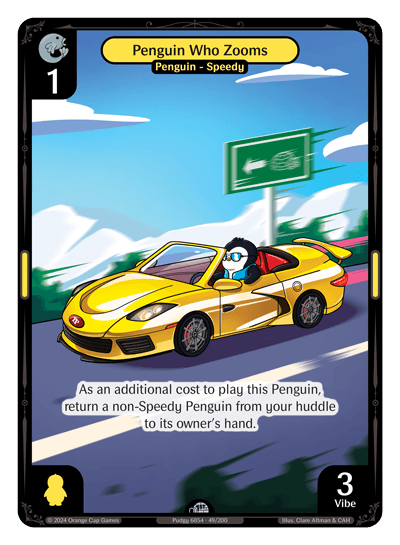 and Inquisitive Penguin
and Inquisitive Penguin , though the dynamics there can be very different. Remember that these are the only 1 drop penguins in the game right now, and the only other way to play a bird on turn one would be playing and subsequently losing Freezing Rod
, though the dynamics there can be very different. Remember that these are the only 1 drop penguins in the game right now, and the only other way to play a bird on turn one would be playing and subsequently losing Freezing Rod , which is not a play any deck wants to make in the current meta.
, which is not a play any deck wants to make in the current meta.
Vibes has an interesting core mechanic that not many other games can claim, and that is that winning early (ie. winning the vibe check) can be a punishing mechanic. Both players will net the same amount of cards overall, but the winner gains acceleration while the loser gains options. It is one of the few games I have ever played that openly asks the player if they want to win any given turn, and the answer can often be no. Complicating the equation more are ties, which result in the game slowing down as both players net 1 fewer card.
When you commit a 1 drop on turn one, what you are saying about your game plan is that you are either seeking to win early (Yellow is one of the few decks that can do this via card draw) or that you need the acceleration to play costlier cards and not have dead turns. You are signaling what deck you are playing and that you are ok with seeing fewer options because you have a game plan in hand. This gives a lot of information to your opponent about how they may want to adjust their strategy, and can potentially backfire down the line if you get into topdeck mode and draw poorly.
Committing to a turn 1 Flying Penguin sets in motion all your subsequent turns, even if you only win the first vibe check. Quality players may even be in a position to recognize the situation you are committing to and change the nature of their plays as a result, attempting not to win the vibe check on subsequent turns to sculpt a better hand or lead you into over-extending.
sets in motion all your subsequent turns, even if you only win the first vibe check. Quality players may even be in a position to recognize the situation you are committing to and change the nature of their plays as a result, attempting not to win the vibe check on subsequent turns to sculpt a better hand or lead you into over-extending.
Knowing what your plan is, and understanding what your opponent's plan may be is key to knowing what the right play is.
What is your Role
Talk to any veteran Magic player and they will tell you one of if not the most seminal articles in Magic is Who’s the Beatdown. This article, which is almost as old as Magic itself, set the standard for role assignment in the game. Misassigning your role as the aggressor or the defender is almost certainly going to lead to a loss in most games, provided your opponent does not make the same mistakes. While the rules of the games are different, the principle remains the same, and playing a turn one penguin onto an empty board is one of the most prominent ways to assign yourself the aggressor role.
In Vibes, since we do not have much if any information turn 1 and we do not have any other indicators as to what deck an opponent is playing past the cards they visibly lay down, you are making this assessment blindly most of the time. If you have the baron turn 1 you fully have 0 indicators as to what your opponent is playing, and if you go second the only real information you can glean is if your opponent played a turn 1 penguin or a rod card face up.
So making this assessment has to be primarily based on your knowledge of your own deck, what is in your opening hand, and what it tells you about what the next few turns will look like if things go right (or things go wrong).
What Happens When you Misassign
Let’s say your are playing the following list (my idealized Yellow deck right now)

Yellow Combo


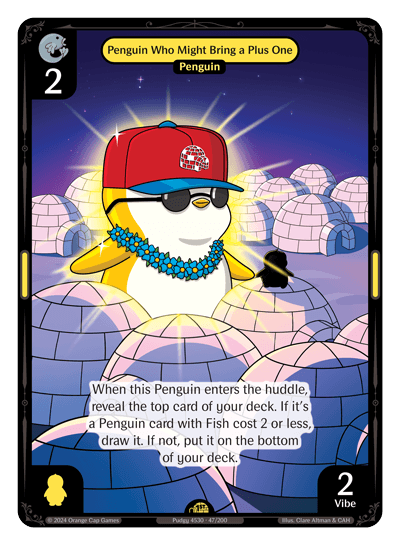
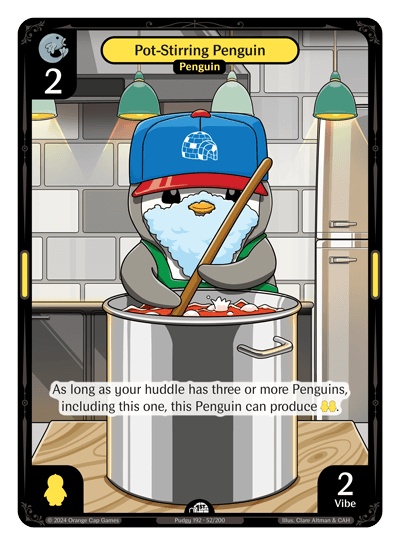
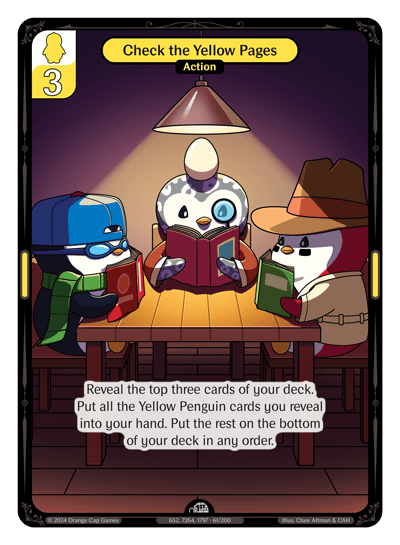
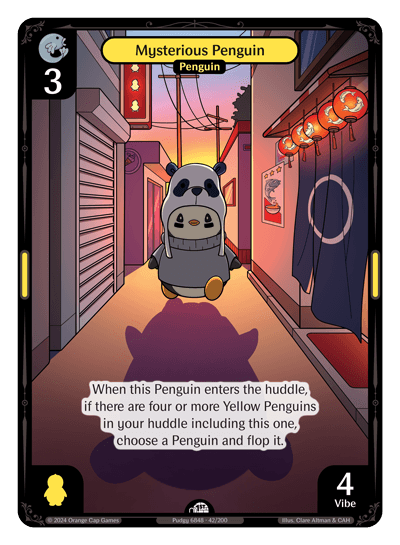
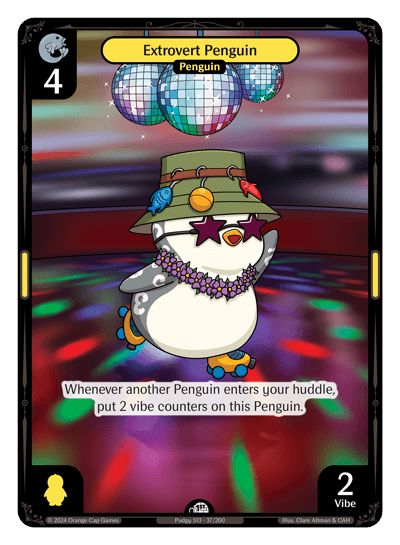
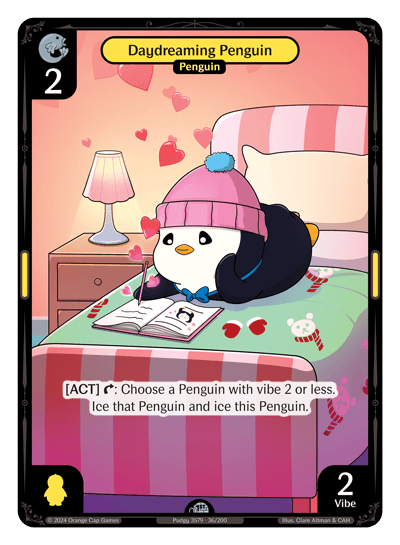
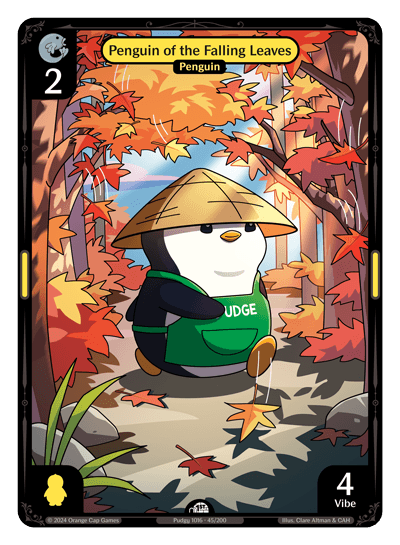
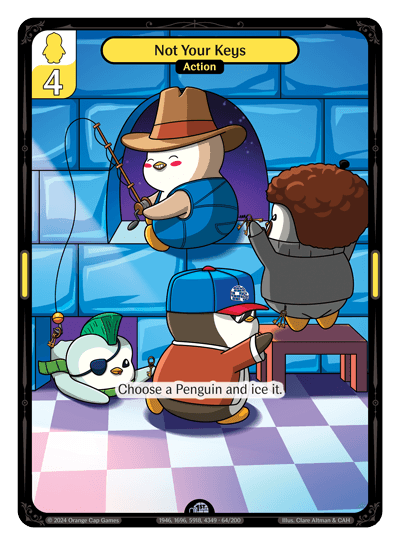
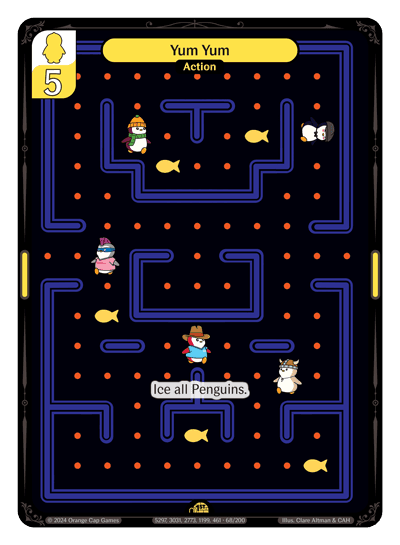
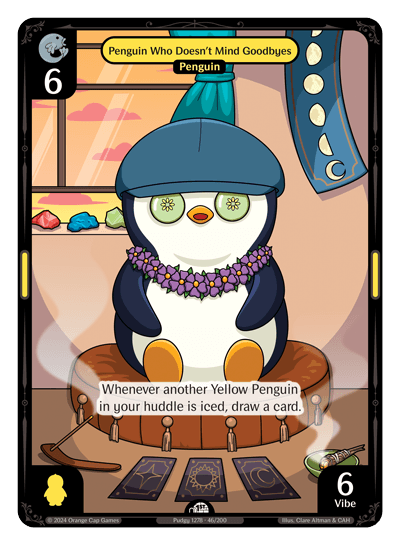
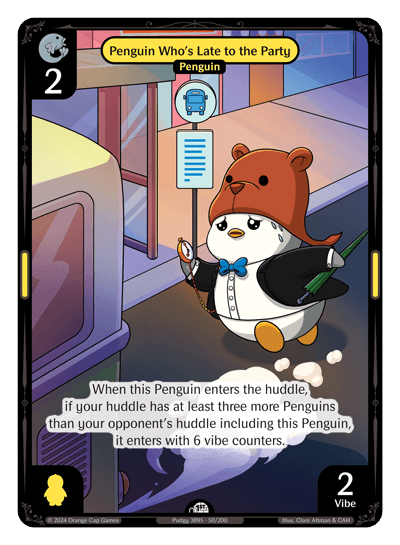
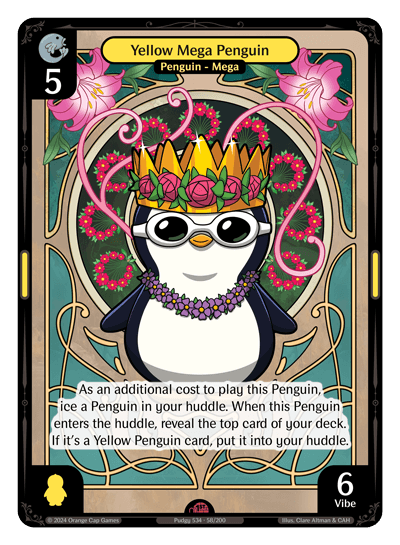
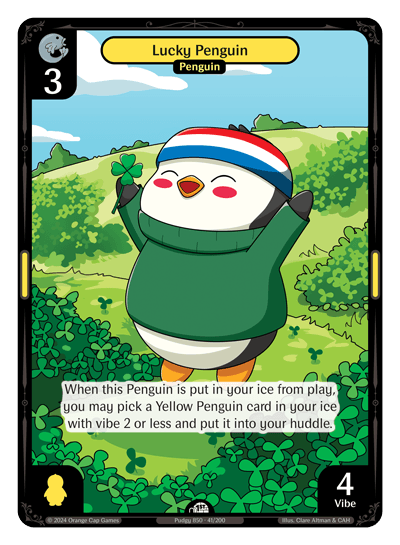
Your opening draw is completely unplayable, so you pitch your whole hand and draw the following:
1 x Flying Penguin
1 x Check the Yellow Pages
1 x Extrovert Penguin
1 x Yum Yum
1 x Penguin That Doesn't Mind Goodbyes
You win the Rock/Paper/Scissor match and draw another Yum Yum . You decide to put the extra Yum Yum
. You decide to put the extra Yum Yum into your rods and play your Flying Penguin
into your rods and play your Flying Penguin , thinking your game plan is to draw into some more penguins on subsequent turns and fire off a Check the Yellow Pages
, thinking your game plan is to draw into some more penguins on subsequent turns and fire off a Check the Yellow Pages to try and get to 15 before your opponent can really mount an offense. If you can get Extrovert Penguin
to try and get to 15 before your opponent can really mount an offense. If you can get Extrovert Penguin online early it can probably carry you all the way, and you even have the Yum Yum
online early it can probably carry you all the way, and you even have the Yum Yum and Penguin That Doesn't Mind Goodbyes
and Penguin That Doesn't Mind Goodbyes combo ready to go.
combo ready to go.
Your opponent plays a rod and passes, you win the vibe check and go up a rod and go on to turn 2.
You draw Not Your Keys . It is now turn 2 and you are already in a situation where you cannot play anything for lack of a 2 or 3 drop. You decide that the next play you can reliably get on to the board is the Extrovert Penguin
. It is now turn 2 and you are already in a situation where you cannot play anything for lack of a 2 or 3 drop. You decide that the next play you can reliably get on to the board is the Extrovert Penguin , so you need to capitalize on your rod advantage and get to 4 as soon as you can. You rod your Not Your Keys
, so you need to capitalize on your rod advantage and get to 4 as soon as you can. You rod your Not Your Keys and pass. Your opponent plays a rod and plays Contemplation Penguin
and pass. Your opponent plays a rod and plays Contemplation Penguin . No one has any actions and the round ends in a tie. You go to turn 3 and draw Penguin Who Zooms
. No one has any actions and the round ends in a tie. You go to turn 3 and draw Penguin Who Zooms .
.
You look at your hand and realize your only lines are to play the Penguin Who Zooms and maybe replay the Flying Penguin
and maybe replay the Flying Penguin , or go for the Extrovert Penguin
, or go for the Extrovert Penguin . The Extrovert Penguin
. The Extrovert Penguin seems like the better play since the Penguin Who Zooms
seems like the better play since the Penguin Who Zooms can pump him on later turns, but to keep that scenario you either have to give up one of your combo pieces or your draw engine. You decide to keep Check the Yellow Pages
can pump him on later turns, but to keep that scenario you either have to give up one of your combo pieces or your draw engine. You decide to keep Check the Yellow Pages because it can come online next turn and play Penguin That Doesn't Mind Goodbyes
because it can come online next turn and play Penguin That Doesn't Mind Goodbyes to your rods and put the Extrovert Penguin
to your rods and put the Extrovert Penguin into play. Your opponent plays a rod and plays Peace Out Penguin
into play. Your opponent plays a rod and plays Peace Out Penguin . You go to actions and have nothing to do. Your opponent plays Heads I Win, Tails You Lose
. You go to actions and have nothing to do. Your opponent plays Heads I Win, Tails You Lose and forces you to discard, then uses their Peace Out Penguin
and forces you to discard, then uses their Peace Out Penguin to Ice both your in play penguins. The turn ends in another draw and you start turn 4 with 4 rods, 2 cards in hand you cannot play for some time, and an empty huddle. Barring your opponent from drawing absolutely terribly for the next few turns, you have probably lost this game.
to Ice both your in play penguins. The turn ends in another draw and you start turn 4 with 4 rods, 2 cards in hand you cannot play for some time, and an empty huddle. Barring your opponent from drawing absolutely terribly for the next few turns, you have probably lost this game.
So what went wrong here? You played your Flying Penguin turn one. You wrongly determined you would be on the offence and your opponent was able to counter it, setting them up with +1 card advantage on turn 4 and with more tempo on board. Your inability to capitalize on your accelerated rods caused you to have no action on turn 2 and left you without options on all your subsequent turns. Had you not won that first vibe check you may have been able to draw into a solid turn 2 play or at least set up your subsequent turns better, enabling you to fire off your card advantage and leaving you with a 1 drop in hand to potentially power up your Extrovert Penguin
turn one. You wrongly determined you would be on the offence and your opponent was able to counter it, setting them up with +1 card advantage on turn 4 and with more tempo on board. Your inability to capitalize on your accelerated rods caused you to have no action on turn 2 and left you without options on all your subsequent turns. Had you not won that first vibe check you may have been able to draw into a solid turn 2 play or at least set up your subsequent turns better, enabling you to fire off your card advantage and leaving you with a 1 drop in hand to potentially power up your Extrovert Penguin on later turns. This one decision set the pace and the decision tree for the entire rest of the game.
on later turns. This one decision set the pace and the decision tree for the entire rest of the game.
So when do you play it
There is no hard and fast rule I can give you here, sometimes you are just making an educated guess. But the key to making that guess is understanding your plans, your pivot points, and what your opponent may do. There are some heuristics that a well versed player can use however to help you determine what your move should be.
Observe the mulligan?
I think this is often overlooked but note how many cards your opponent sent back during the mulligan phase. This is solid advice for any deck and any game plan because it does give you at least an indication of how confident your opponent is with their hand.
Did they keep their full hand without sending anything back? That tells you they feel confident that they can execute what their deck is trying to do. You can assume against a good player this means they have the curve they want to see and the cards their deck needs to run smoothly, so unless your strategy is heavily advantaged you have a real game ahead of you.
Did they pitch 4 or 5 cards? That tells you they are either fishing for something or they just had a terrible hand. While they could have drawn into exactly what they wanted to see, the odds in this case are much lower and therefore they are less likely to be able to execute their game plan. While I am not saying you should use this as an excuse to play the aggro game on it’s own, combined with other indicators it could tell you that you have some wiggle room to take risks if needed and force them into a situation where they need a quick answer to your strategy or they will lose.
Did they go first?
When you go first and play a Flying Penguin , you are giving up a lot of information, but that is a two way street. If your opponent goes first and drops down a 1 drop it can really help you craft your next few turns.
, you are giving up a lot of information, but that is a two way street. If your opponent goes first and drops down a 1 drop it can really help you craft your next few turns.
Did they play an Inquisitive Penguin into a Penguin Who Zooms
into a Penguin Who Zooms ? Well now you know 2 of their cards and know for a fact that you are not winning the vibe check with a 2 vibe penguin, so unless your hand happens to be 2 more Flying Penguin
? Well now you know 2 of their cards and know for a fact that you are not winning the vibe check with a 2 vibe penguin, so unless your hand happens to be 2 more Flying Penguin and a Check the Yellow Pages
and a Check the Yellow Pages you may not have the incentive to bother playing it out at all. Will you potentially need that 1 drop on later turns to play out a Shy Penguin
you may not have the incentive to bother playing it out at all. Will you potentially need that 1 drop on later turns to play out a Shy Penguin on 5 rods to catch up with the vibe checks?
on 5 rods to catch up with the vibe checks?
Did they play out Contemplation Penguin ? Well now you know they are on Red and may want to play out your 2 drop to tie the vibe check and prevent them from seeing too many more cards in their hand so they cannot combo off.
? Well now you know they are on Red and may want to play out your 2 drop to tie the vibe check and prevent them from seeing too many more cards in their hand so they cannot combo off.
There is no hard and fast rule here, the cards in your hand and your gameplan are what is going to drive your next decision, but knowing the plays you have against the different archetypes in the game is a huge step towards making the right decision.
Do you have a curve?
Sometimes your gameplan and educated risks are going to be your only guideposts. A hand with no 2 drops but a 3 and 4 cost Penguins are going to make you want to play your one drop for the acceleration in hopes that it can turn on action cards you draw later on, since you have a turn 2 and turn 3 play ready.
A hand with Penguin Who Might Bring a Plus One and a Penguin Who Zooms
and a Penguin Who Zooms may make you want to accelerate to get the draw engine on line, or if that hand has no other early action but reactive penguins may make you wait and use the 1 drop as your rod for the turn.
may make you want to accelerate to get the draw engine on line, or if that hand has no other early action but reactive penguins may make you wait and use the 1 drop as your rod for the turn.
Know your deck, know the odds of drawing into what you want to see, and make sound judgments based on the odds and based on what you need to win.
In summation
As the game grows, the dynamics of playing a 1 drop penguin on turn one may change completely. If more colors gain access to good one drops, more draw cards are printed, and cheaper actions come into the equation, we may see a shift in the meta to decks with lower overall cost and totally new strategies, or completely away from it. Even first turn relics which are not really a thing right could be in the future. Who knows?
But the lessons above will still apply. Know your role assignment, know your deck and game plan, know the meta, and know that sometimes you have to make a guess and run with it. You still won’t always know if playing a turn 1 Flying Penguin is the right move, but at least you will not regret not knowing if you threw your whole game away on turn 1.
is the right move, but at least you will not regret not knowing if you threw your whole game away on turn 1.





